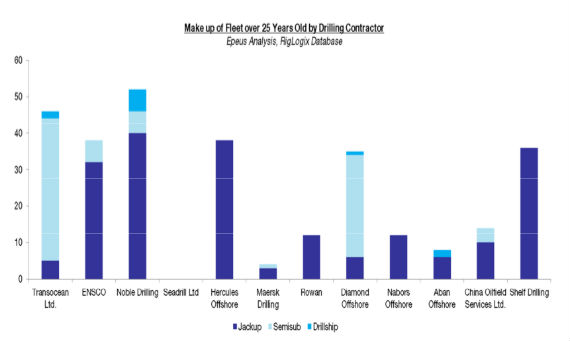Deepwater Drilling Rigs: high risk, high return
It is argued that the global drilling rig industry is in the middle of the biggest build boom since the 1980s. This is due to a number of key factors, including a steady projected increase in demand, especially for deepwater rigs that can drill in depths greater than 4,000ft.
On the one hand, daily rates for these rigs have tripled since 2004 to about US$5000,000 per day supporting the argument of demand outstripping supply. On the other hand, however, one can argue that oil prices have not seen such a dramatic increase and are not forecasted to rise so rapidly. In addition, there is the argument that oil companies are cutting on their capex[1].
Despite such arguments, another key factor that is a boon for rig builders are the ageing fleets of the drilling contractors. According to Epeus, almost 25% of the Mobile Offshore Drilling Units (MODUs) in the world are more than 35 years old and another 26.5% are between 31 years and 35 years old. Therefore, assuming a useful life both economically and practically of 40 years, over 50% of the MODUs in operation today will have to be retired in the next 10 years.
Some of the drilling contractors most affected by this ageing trend include Nabors, with 100% of its fleet greater than 25 years old; Shelf and Hercules with 97.3% and 95% respectively of their fleets greater than 25 years old. In contrast, SeaDrill has none of its fleet greater than 25 years old and the younger as well as diversified nature of their fleet enables them to achieve almost 70% of their fleet fully contracted. This translates to a relatively high price/earnings ratio of 12.

According to Morgan Stanley, deepwater rig supply is expected to grow by almost a fifth by 2016. With an average price of US$600m for a new build drillship and similar prices for submersibles, this makes it an exciting time to be in the rig building industry. For drilling contractors, it is less clear. As always, one has to be aware of the key risk factors and their costs implications, otherwise financial performance could be compromised.
[1] FT.com, "Oil rigs: heavy water", 24th March 2014.









 Facebook
Facebook Linkedin
Linkedin Instagram
Instagram Youtube
Youtube EMC Newsletter
EMC Newsletter







